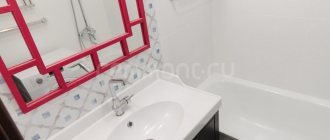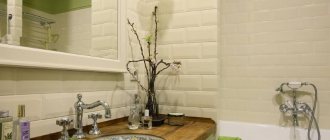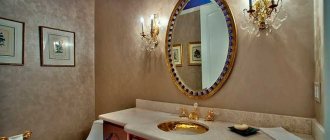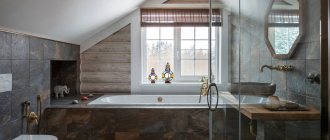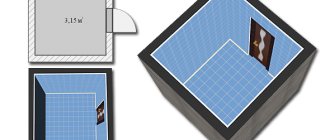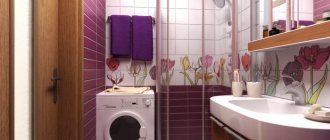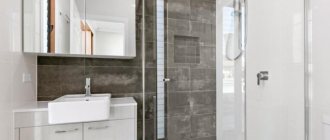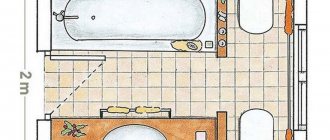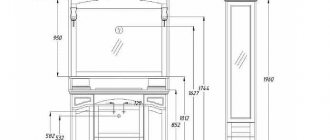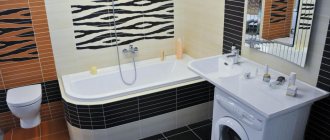A small toilet or bathroom is a problem in most homes built between 1950 and 2000. Apartment owners often think about remodeling their bathroom and toilet - dividing or expanding them - but often make critical mistakes that make the procedure illegal and even dangerous.
To avoid this, at the planning stage you need to familiarize yourself with the legislative framework and find out exactly how changes can be made and which plans will have to be abandoned.
Do's and Don'ts
In a brick or panel house, certain changes can be made regarding the bathroom. By law, the following is permissible:
- Removing the septum. With this action, you can significantly increase the usable area of the bathroom and toilet: it will be possible to install a larger shower or bathtub, it will be possible to install additional furniture or equipment.
- Using non-residential space to increase the area of the bathroom. This implies an increase in the size of the room for water procedures due to the corridor or built-in closet, storage room.
- Changing the position of the bathroom. In this case, complete or partial redevelopment of the room is allowed, but only when, according to the classic layout, the bathroom is located above the non-residential area of the neighbors below. The complete relocation of the hygiene room must be coordinated by law with mandatory waterproofing of the floor and re-equipment of ventilation.
In order for the redevelopment of a toilet to be legal, it must be coordinated with utility services and the housing inspection.
Prohibited changes
Owners cannot plan to remodel a bathroom in an apartment if it affects at least one of the following aspects:
- Using the living space to enlarge the bathroom. The law prohibits expanding or moving a bathroom above the neighbors' living area, which is associated with the risk of flooding.
- A door leading into the kitchen or bedroom from the bathroom. The only exception is a disabled person’s home, or the presence of a second bathroom, the layout of which fully complies with legal standards.
- Ventilation shafts are not used correctly. If the layout involves installing shelves or other furniture in the bathroom, as well as artificially narrowing or moving the shaft, then this is prohibited by law.
Illegal bathroom remodeling primarily affects the rights of neighbors and safety standards. And this leads to emergency situations and security breaches.
Peculiarities of restructuring approval
The home owner can take two routes to approve the redevelopment:
- The easy way. If the changes only affect the demolition of the partition without increasing the area allocated for the bathroom, then it is enough to spend a small amount of time visiting the BTI. The owner draws up a sketch or project of measures, and then, together with the employees, removes the partition in the apartment plan in the appropriate structure. The position of the plumbing remains the same.
- If you need to change the position of the bath or increase the area. Relocating a sink, toilet or bathtub is only possible if the liquid waste disposal system remains intact. Changing the location of the bath is considered a serious intervention in the layout of the apartment. If an increase in the bathroom area is required, then a complete package of documents is prepared: a draft of changes, the consent of all owners of the apartment, a passport for the apartment, as well as the owner’s passport, documents confirming the right to own housing.
In the second case, it is necessary to create a commission that will assess the upcoming redevelopment and identify non-compliance with legal norms. If there are no violations, the owner will receive permission to repair. Also, after carrying out the work, the commission must make sure that the repairs were carried out in accordance with the previously submitted sketch or project.
When is a sketch needed, and when is a project needed?
Drawing up a sketch or project is a parameter that depends on the complexity of the proposed work. The apartment owner cannot choose at his own discretion the type of organization of the proposed project.
Important! The sketch can only be used when the changes do not involve a significant restructuring of the area. This type of diagram is used mainly when moving plumbing fixtures within an area, as well as when demolishing a partition. You can also use the sketch in the case where you plan to shift the doorway.
Major repairs that may pose a danger to neighbors must be accompanied by the preparation of a project. The sketch is submitted for approval to the BTI, and no commission is required - approval takes place according to a simplified procedure.
If the apartment is not going to be sold in the near future, then approval can be postponed, but it should be remembered that detection of changes by BTI employees without inclusion in the registration certificate involves a fine.
If the redevelopment involves changing the area of the restroom, moving large plumbing fixtures, and a sink, then drawing up a full-fledged project is required. After this, it is approved and checked again after implementation. If you strictly follow the advice and recommendations, then mistakes and illegal actions can be avoided.
Permissible changes in the bathroom and restroom
According to the law, bathroom redevelopment is possible in the following directions:
- Combination. If the bathroom and toilet take up little space, making it difficult to use them conveniently, then you can remove the partition to allocate space. However, this option is not always acceptable.
- Separation. A simple redevelopment method that requires the installation of a small partition. Like the first method, it does not apply to the overhaul procedure.
- Extension. Complete, large-scale renovation of the bathroom using additional non-residential space (hallway or storage room).
- Changing the door position. This procedure is often used during redevelopment in houses of the Soviet period. If you move the door, you can allocate a lot of useful space, for example, to install a sink or washing machine.
- Relocating a bathroom. The law allows the toilet to be moved to any place that meets the requirements of SNiP. Most often, redevelopment with the relocation of plumbing fixtures (bathtubs, sinks, toilets) is used in large apartments and private houses.
The owner of the apartment should be guided by personal preferences and the ease of use of the bathroom, but should not forget about the legislative norms and rules for approving a sketch or redevelopment project.
How to coordinate the redevelopment of a bathroom and toilet in 2021
Coordination of work must begin before the bathroom is expanded or moved to another room. Otherwise, you will have to legitimize the repair “retroactively.” And it is not a fact that this will be implemented in practice.
Procedure
The steps may vary depending on the region, type and series of the house. We will indicate the main stages that are inherent in agreeing on the redevelopment of a bathroom in an apartment:
- First of all, you need to consult the redevelopment approval department of the administration in your area. For example, in Moscow this is the Moscow Housing Inspectorate, and in the regions - the departments of architecture and urban planning. Next, get advice from the design office regarding the upcoming redevelopment of the bathroom.
- Order a technical passport or an explication and floor plan of the apartment. They are issued by the BTI on the basis of a passport and a document on ownership of the apartment.
- Conclude an agreement with the design organization. She will be tasked with making a bathroom and toilet remodeling project in accordance with your ideas. The organization must have SRO permission to develop project documentation. You can check if you have permission on the Nostroy website. After concluding a contract, a company engineer will visit the site, after which specialists will prepare a project for redevelopment of the “wet areas”. A technical opinion may also be required.
- Submitting an application for project approval. Contact the nearest MFC, where they will accept your application and documents, after which they will be forwarded to the housing authority for consideration.
- Obtain permission to remodel the bathroom.
- Beginning of construction work within the framework of the drawn up redevelopment project. Deviation from the plan is prohibited. It is better to entrust the repair to a construction company with SRO approval - in this case, they will be able to lay a layer of waterproofing themselves, generate hidden work reports and fill out a construction work log
- Write an application for the issuance of a certificate of completion of redevelopment. The application and documents are submitted to the MFC, from where they will be forwarded to the architecture department. Next, a representative of the government agency will contact you and agree on the date and time of the repair inspection.
- Submit the redevelopment to the inspection commission. It usually includes an engineer from the supervisory authority. On your side there should be representatives of the construction team and the design bureau. If the repair complies with the project and meets all standards, the inspector draws up a report on the completion of the redevelopment. It must be signed on the spot, but collected later at the housing authority.
- Order a new registration certificate. With a completed certificate of completed redevelopment, you need to contact the BTI and invite a technician. He will take measurements of the bathroom. Based on these measurements, the Bureau will make changes to the technical records, and you will be issued a new registration certificate for the apartment.
- Make changes to cadastral registration. The final stage is to contact the MFC with an application to invite a cadastral engineer. He will take measurements and transmit the information to the Unified State Register of Real Estate. Next, government agency specialists will enter information about the redevelopment into the cadastral register. The owner will only have to receive a new extract from the Unified State Register of Real Estate.
Individual stages may change, but in practice, the procedure for approving the redevelopment of a bathroom looks exactly like this.
Required documents
Now let's go through the documents that are needed to obtain permission to expand or combine the bathroom and toilet.
The list is as follows:
- an application on behalf of all apartment owners, and if it is not possible to come to the MFC all together, a power of attorney is drawn up for one person - he will deal with all the paperwork;
- title documents for the apartment (donation agreement, certificate of inheritance, privatization);
- floor plan and explication - included in the technical passport of the apartment;
- ready-made project for redevelopment of “wet areas” + technical specifications on the safety and permissibility of work;
- an agreement on designer's supervision, a production work log, a certificate of admission of the SRO company and other documents included in the project documentation.
In addition, other documents may be required. We are talking about a bank permit, a certificate from Gorgaz, a notarized power of attorney, and a permit from an architectural authority. The list is individual and may change.
Cost of approval
There is no need to pay for the issuance of a redevelopment permit - the service is free.
The costs include the preparation of a bathroom and toilet remodeling project. It is cheaper to arrange the demolition of a partition or the relocation of plumbing fixtures. The situation is more complicated with moving partitions and expanding the bathroom at the expense of the corridor. The cost of the project ranges from 5,000 to 70,000 rubles. Technical conclusion is paid separately.
Changes resulting from redevelopment in the BTI and Rosreestr will cost from 5,000 rubles and more.
Deadlines
Coordination of renovation work in the bathroom and toilet takes on average from 3 to 6 months. Of these, 45 days will be considered for the application for permission to remodel the bathroom - by virtue of clause 4 of Art. 26 Housing Code of the Russian Federation.
You need to wait another 10 days for changes to be made to the BTI database and about the same number of adjustments in the cadastral register.
The period for issuing permission for redevelopment is 1 year, with the possibility of extension for another 6 months. It cannot be extended any further.
Combination of toilet and bathroom
The most popular way to remodel a bathroom is to combine it with a bathroom. By increasing the space, the apartment owner can add new furniture and other items to the restroom.
Important! The partition between sanitary departments is easy to demolish and in 99% of cases is not load-bearing. Therefore, the procedure for its demolition is considered simple and does not require significant permits and a long study of the sketch in the BTI.
By removing the partition, the owner has the opportunity to comfortably place a washing machine, large bathtub or shower in the restroom. Here are the benefits this procedure provides:
- eliminating the doorway of one of the rooms significantly expands the layout options of the bathroom - items are placed more conveniently;
- In many homes, bathroom communications take up a large space and are extremely inconvenient to use. Redevelopment allows you to get rid of this discomfort;
- You can save on wall cladding and installing an additional door.
If the redevelopment makes it possible to install a door that opens outward, then this saves even more space and increases the functionality of the room.
Features of layout in houses of different types
In Khrushchev-era buildings, the partition in the restroom is never load-bearing, so removing it does not pose a danger to neighbors below or above. In panel houses the situation is somewhat different.
In some buildings, the partition in the restroom performs a load-bearing function, so even at the planning stage it is necessary to make sure, using the technical passport, that it is possible to remove the wall between the toilet and the bathroom.
Remodeling a bathroom can also be complicated by the fact that in a panel house the partition consists of reinforced concrete. It is much more difficult to break than a brick wall. For dismantling, you will need an angle grinder, supports and extreme care - without following the technology for breaking the wall, there is a high risk of its collapse.
Features of bathroom separation
You can separate the toilet, shower and bathtub in different ways. The most drastic of them is the construction of a brick wall. To do this, you need to take into account the following requirements:
- create a design and approve it in BTI;
- study the position of water pipes and move them if necessary, and also change the position of plumbing fixtures and meters;
- You will need to install an additional doorway for a toilet or bathroom.
Instead of a brick wall, you can use modern methods of dividing space: installing a glass panel or decorative wall, using a folding screen, or arranging pieces of furniture to harmoniously divide the space.
All these methods are considered to be quite functional and do not require major intervention in communications. The construction of an additional brick wall can also be complicated by the fact that it carries a significant load on the floors.
How to remodel a bathroom: step-by-step instructions
Since the question of whether it is possible to enlarge the bathroom at the expense of the kitchen is answered negatively in most cases, let’s consider the general scheme of actions when making changes to the layout of the bathroom:
- Get a technical passport for the apartment . Issued by the BTI. Can be ordered through the multifunction center. When registering, you will need to pay a state fee of 1000 rubles. The document contains a detailed housing plan. This shows the exact area of the apartment and the inventory price. Information about the general condition of the house is recorded: date of construction, condition, communications, plan for major repairs, etc.
- Order a redevelopment project or create it yourself . The drawing is ordered from any design organization. If the work is simple, for example, you want to combine a bathroom and a toilet, then the drawing can be done by hand. Please familiarize yourself with the features of such plans in advance. If you are planning to carry out more serious work, then contact an authorized organization for the project. This is especially true if the redevelopment affects load-bearing walls.
- Collect and submit documents . The review period is 45 days. After the reception, you will be given a document indicating that the documents have been accepted for consideration. Documents are accepted by multifunctional centers and local administrations. You can also submit an application remotely through the State Services portal. If all documents are completed correctly and there are no complaints about the project, you will be given consent to carry out the work. It is valid for a year. If you do not have time to complete the redevelopment within this period, you will need to repeat the procedure.
- Approve the final project . Development is carried out on site. If you contacted an authorized organization, an employee will assess the condition of the bathroom and draw up a technical report. The project is submitted for consideration by Rospotrebnadzor. The assessment period is 2-3 months.
- Implement redevelopment . The duration of the work depends on the competence of the construction team. On average, a simple redevelopment takes 3 months. If you plan to do it yourself, the time period will be longer. It is important that the final version corresponds to the project stated in the documents. If there are any discrepancies, revision or rework will be required.
- Draw up a new apartment plan . Ordered from BTI. Next, the right to own the property with individual redevelopment is issued. A specialist will evaluate the construction work. Make sure they comply with the approved plan. Based on the measurements, a new technical data sheet will be issued. Processing time is 1-2 months. The cost of the service is 2-3 thousand rubles. After registration, provide new data about the property to the Unified State Register of Real Estate.
Replacing a bath with a shower
Many apartment owners are perplexed by remodeling the bathroom without destroying or erecting walls - only by changing the position of the toilet, bathtub and shower. Moving plumbing fixtures indoors without construction is only possible in certain cases.
So, if devices are marked in the technical plan of the BTI, then changes in their position must be agreed upon in accordance with clause 1 of the Appendix to the Government Resolution (they may differ in different cities). To transfer them, a sketch is required.
Most often, BTI marks the position of the sink, shower, bathtub and toilet in the plan. If the owner of an apartment wants to remove the bathtub and install a shower stall, then he needs to contact the BTI and agree on the stages of changes. But moving a heated towel rail or installing a washing machine does not require such approval and is not noted in the BTI plans.
Unauthorized redevelopment
It happens that people don’t know how to legitimize changes in the bathroom or simply don’t want to do it . There is a fine for unauthorized redevelopment. For individuals it ranges from 1 to 3 thousand rubles. The size depends on the scale of the changes. The quality of the redevelopment is taken into account - if you demolished a partition, that’s one thing, but if you removed a load-bearing wall, that’s another.
There are two ways to agree on an already completed project: through the court or through the Interdepartmental Commission. In any case, the premises will have to be returned to their original condition.
The court may decide to preserve the changes only if it is determined that they comply with regulatory requirements for the condition of the living space and do not worsen the living conditions of neighbors.
How to coordinate such changes
To approve unauthorized changes, follow these steps:
- Assess the scale of changes: take measurements, identify inconsistencies.
- Collect documents for the apartment, which record the original plan of the living space.
- Invite a specialist. This is required if there are serious discrepancies with the plan. He will conduct a technical examination and assess the scale of the redevelopment.
- Contact the design organization. The necessary documentation will be drawn up there. They will create a project taking into account current changes.
- Order an examination to determine the adequacy of the transformations.
- Contact the housing inspection to approve a new project. If refused, go to court. You can appeal the decision within 3 months after it is made.
If the decision is positive, you will need to issue a new cadastral passport and provide data to the Unified State Register of Real Estate.
How not to buy an apartment with unauthorized redevelopment
There is a risk of buying an apartment with unauthorized redevelopment . Often, owners demolish partitions, combine bathrooms, and expand the area of the bathroom. However, changes are not recorded in official documents.
To avoid a fine, you need to determine whether redevelopment has been carried out. To do this, study the technical plan of the apartments of this building or the selected type of housing. You can also contact the BTI for a plan for a specific property.
In order not to doubt the seller and the apartment, you should check the following documents:
- certificate for the apartment;
- title deed;
- extract from the Unified State Register of Real Estate;
- passport for the property
Take your time when completing the transaction . Carefully check everything, from the seller to the history of the apartment itself. Don't go for cheap. An apartment with a clearly undervalued price should first of all arouse not delight, but suspicion.
Fraudsters often put such properties up for sale in order to quickly attract buyers. Read all the documents and visually evaluate the home. Traces of redevelopment can be visible to the naked eye.
Moving a bathtub or toilet to another location
Since the sink and bathtub require pipes with a diameter of 50 mm with a slope of 2 to 4 degrees, moving them does not cause significant problems (be it a panel or brick house). Proper installation of plumbing ensures the natural elimination of liquid waste.
Important! Laying a sewer system without a slope will cause water to stagnate. This leads to blockages and the constant presence of unpleasant odors.
Changing the position of the toilet is somewhat more difficult, since it needs a large diameter pipe - 10 cm. It is important to remember that it is also located at an angle. The transfer procedure is complicated by the presence of “elbows” (corners) in the pipe. It is important to remember hygiene standards: the toilet is always installed in pairs with a sink, or a sink with a bathtub (although this method is used less frequently).
Features of installing additional equipment
Such parts of the restroom as a heated towel rail, washing machine, drying cabinet are installed in accordance with certain requirements of logic and convenience.
So, the heated towel rail must be located next to the water communications, otherwise this will lead to a change in water circulation and a general decrease in its temperature. Of course, if an electric heated towel rail is installed, then this requirement may not be adhered to.
Advice! Choose dryer models without many thin parts and narrowings, otherwise water will not circulate well in them. In addition, over time, scale and other contaminants accumulate in narrow places, which will lead to a sharp narrowing of the duct.
It is best to opt for a dryer, the size of which is 60 by 80 cm. You can choose any type of electric heated towel rail - the main thing is not to overdo it with the size, otherwise it will be too hot in the restroom. Connecting a washing machine requires a cold water supply and sewerage, but these procedures do not require coordination.
Arbitrage practice
The practice of enlarging the kitchen at the expense of the bathroom or toilet comes down to the fact that the misdeed takes the side of the defendant, namely, it prohibits enlarging the kitchen and moving the bathroom, or expanding the kitchen and narrowing the bathroom.
This decision is dictated by the following standards: SanPiN2.1.2.2645-10 and clause 9.25 SP 54.13330.2016.
But every rule has exceptions: you can expand the kitchen at the expense of a bathroom if there is a non-residential premises under the apartment or if the owner plans to remodel the second floor of a two-story apartment.
Enlarging the bathroom at the expense of a room or corridor
In order for a bathroom remodel to be legal, it is important to take into account legal requirements. Many apartment owners are thinking about expanding the area by adding a corridor or living room. But this is not possible in every case.
Combining the bathroom and part of the living room
SanPiN prohibits the use of living rooms to expand the bath and toilet, but only if they are located above the living room or kitchen of the neighbors below. Increasing the restroom at the expense of the living space is possible in two-level apartments if they are located above the kitchen on the first level.
Relocating a bathroom during redevelopment by using a kitchen or living space is impossible in ordinary apartments, and there can be no exceptions here. This prohibition, however, does not apply to a laundry room in which a dryer and washing machine are installed, and there is no plumbing such as a toilet or sink.
Therefore, it is prohibited to move the bathtub and toilet into the kitchen, as well as the installation of an additional toilet in the kitchen area. Relocating a bathroom by using a living room located above a utility room or basement (on the 1st floor) is possible, since no standards are violated.
Enlargement of the bathroom due to the corridor
There is no prohibition on moving a bathtub and toilet if non-residential premises are involved: a corridor, a storage room, a utility room, a built-in closet. Such redevelopment can be approved by the BTI. If it is planned to organize an additional bathroom on the territory of a non-residential premises, then this is also acceptable.
The only problem is that organizing an additional toilet requires laying sewers along the walls. For these cases, the installation of special pumps is provided that remove sewage from any location.
What are the consequences of illegal bathroom and toilet remodeling?
Unauthorized transfer or expansion of the bathroom is fraught with trouble. If the supervisory authority learns about the violation, the owner will be visited with an inspection, following which they will be obliged to either legalize the repair or return the bathroom to its original state. At the same time, they will issue a fine for unauthorized redevelopment - from 2,000 to 2,500 rubles (Part 2 of Article 7.21 of the Code of Administrative Offenses of the Russian Federation).
If the neighbors below suddenly flood, the culprit will have to compensate for the damage from his own pocket. In this case, it is necessary to prove that the flood occurred due to illegal redevelopment.
Housing with unauthorized alterations in the bathroom is difficult to sell. Buyers will start asking for a discount. And banks do not approve loans for the purchase of apartments with unauthorized changes.
When combining a bathroom and toilet is prohibited or undesirable
There are nuances in which remodeling the toilet and bathroom is considered undesirable, but not prohibited by law:
- Having a large number of people in the family. In the morning and evening, family members will line up to go to the toilet or shower. A separate room in this case will be more convenient.
- Combination of bathroom and kitchen. If you combine the restroom, this will lead to the accumulation of unpleasant odors that can penetrate into the kitchen even if there is high-quality ventilation. Using air fresheners will not correct the situation, as the kitchen will constantly smell of household chemicals.
- Radical elderly people in the family. Not all family members, accustomed to Soviet separate toilets, consider a combined bath and toilet a convenient and correct solution. In some cases, it is better to avoid quarreling and leave the bathtub and toilet separated.
Any redevelopment project must be discussed with all family members, otherwise it can lead to discord and constant conflicts.
Where to go
Before carrying out work on the premises, the redevelopment project is coordinated with several institutions. In this case, the plan for the future bathroom is created by a planning specialist, or drawn by the owner himself.
To coordinate the work you will need to visit:
- Housing inspection;
- Ministry of Emergency Situations to assess the safety of the work being carried out;
- BTI;
- Sanitary and epidemiological station;
- Housing office.
Once the project has been reviewed and approved, work can begin. Upon completion, you need to agree on the final version with what is approved in the documentation. The assessment is carried out by the competent authorities.
Installation of waterproofing, floor and exit
After each redevelopment, it is important to take into account the arrangement of floors in the sanitary unit. The first thing to do is to think about waterproofing, especially when increasing the area. First, the apartment owner dismantles the old floors and then waterproofs them in accordance with the law.
Important! Installation of new waterproofing requires the execution of an act for hidden work - it is signed by a specialist in architectural supervision and the builder, or by an employee of the management company in case of independent repairs.
Waterproofing can be rolled or coated. The second option is most often used, since it is simpler and does not carry a significant load on the floors. Roll insulation requires leveling the floors with a screed.
Coating insulation is considered more airtight and reliable, not requiring a layer of screed. The floor level in the restroom should be 15-20 mm below the level of the finished floor in adjacent rooms. Also in SNiP there is a requirement to install a dividing threshold.
As for creating an exit from the restroom to the bedroom, this also has its own requirements. Thus, SanPiN prohibits equipping a room with a toilet and shower or bathtub with access to the living room. In this case, you can enter from the bedroom if there is an additional room with a toilet and sink, the entrance to which is equipped from the corridor.
Thus, if there is only one restroom with a toilet in the apartment, the entrance to it cannot be through the bedroom or kitchen. If there are two rooms, then one of them can go into the living room or kitchen.
Redevelopment involving mines
Ventilation and sewerage are equipped in strict accordance with the law, so changing them requires permission. This space can be used only after collecting the signatures of the homeowners. Many experts advise not to touch these spaces that are not the property of the apartment owner, since the labor costs will be inconsistent with the benefits received.
Let's sum it up
Redevelopment requires approval . In most cases, you can increase the area of the bathroom only through a corridor or storage room.
However, under certain circumstances, it is possible to expand the bathroom at the expense of the kitchen. In this case, you will need to document your right to change the layout.
All changes can be approved by authorized organizations upon presentation of the corresponding list of documents. There is a fine for unauthorized redevelopment.
What to do after redevelopment
When the apartment owner completes repairs, he must update the technical passport:
- An inspector from the Housing Inspectorate is called to the house.
- The owner receives hidden work certificates from the construction company that carried out the renovation.
- The owner of the apartment receives documents confirming the reconstruction from the inspector.
- A BTI technician is called to your home to take measurements of the premises.
- After some time, the BTI issues a new passport.
Remodeling a bathroom and toilet is a complex but completely doable process. If you find an experienced contractor who takes a responsible approach to construction, or thoroughly study all the issues regarding redevelopment, then you can agree on a plan and obtain permission without unnecessary nerves and waste of time.
It is important to remember that demolishing the partition and changing the position of some plumbing parts is possible in a simplified manner. But enlarging the restroom or partially relocating it is a more complex procedure, requiring a full BTI inspection and the preparation of a package of documents.
Why not?
According to the law, expanding the kitchen at the expense of the bathroom or toilet is unacceptable . This is due to the fact that with such a redevelopment, the apartment owner’s bathtub or toilet will be located above the neighbor’s kitchen below, and placing bathrooms/bathtubs above kitchens is prohibited.
Moreover, it doesn’t matter how far the owner expands the boundaries - whether he goes a little beyond the boundaries or completely moves the kitchen into the bathroom. It is impossible to carry out both full and partial transfer (you cannot even expand by 1 cm).
Combining the kitchen with the room
When combining a kitchen with a room, you also need to take into account the current standards and design features of the apartment. If there is a load-bearing wall between the kitchen and the room, then we can only talk about constructing an opening, which is not always possible in practice.
The conditions that will need to be taken into account for redevelopment with an opening in a load-bearing wall are written in more detail here.
However, even in those apartments where a partition is installed between the kitchen and the room, the possibilities for combining rooms depend on the type of stoves installed in the house.
- If the house has electric stoves, then the kitchen and room areas can be combined directly. To mark the boundaries of the rooms between them, it is advisable to keep small partitions on the sides and a lintel on top (then this can be considered not the demolition of a wall, but the construction of a large opening).
- If the kitchen stove is gas, it is recommended to install a door or a sliding partition (compartment type) with a tight door along the old boundary of the premises, but if the kitchen has a gas water heater, such a demarcation of the premises will be mandatory.
The combination of a gasified kitchen and a room is stated in clause 10.16 of Appendix 1 to Moscow Government Decree No. 508 on redevelopment in apartment buildings.
When combining a kitchen with a living space, the kitchen boundary should remain in the same place.
An example of a redevelopment project combining a kitchen and a room
After dismantling the partition, the boundary between the kitchen and the room began to be marked with a dotted line.
With this combination, the area of the kitchen and the adjacent room remains unchanged. In the design documentation and subsequently on the BTI plan, the boundary between these premises is designated as conditional.
Moving the kitchen into the room is a fine.
If the redevelopment of the living room into a kitchen was nevertheless carried out, then unpleasant consequences may await you. If one of the neighbors or the management company complains about you (most often this happens due to noise, personal conflicts, etc.), then an inspection will come to you. It will detect illegal expansion of the kitchen at the expense of the room or its transfer. Then, in accordance with Resolution 508, firstly, he will issue a fine, which for now is a small amount of 2,500 rubles, but it can be increased in the near future, and, secondly, which is much worse, he will issue an order to return the layout of the apartment in the damaged part to its original state. You'll have to go through costly renovations, putting the kitchen back again. Otherwise, you will be fined again, then the case will be sent to court, which, according to the Housing Code of the Russian Federation, can put your apartment up for auction (and, unfortunately, there have already been such precedents), and this is no joke. In addition, in the future it will be quite difficult to sell an apartment with inconsistencies in the BTI floor plan. At the very least, banks will not approve a mortgage for such an apartment for the buyer.
Example of an apartment redevelopment project
Description 2Description 1
Back
Forward
The cost of creating a redevelopment project, technical conclusion and approval by government agencies can be found below.
Coordination of moving the kitchen to the corridor. Coordination of kitchen remodeling.
If you want to find out the possibility and cost of legalizing the redevelopment of your kitchen, please call us by phone or fill out the call back form using this link. We will be happy to answer all your questions.
ORDER COORDINATION OF KITCHEN TRANSFER
Now let's move on to considering the features of kitchen remodeling, which should not be forgotten when planning it.
